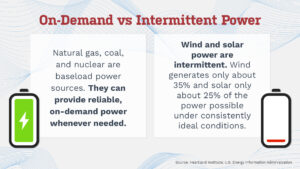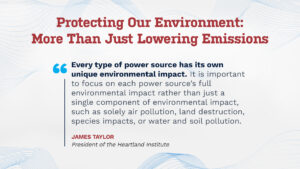
Don’t Just Take Our Word For It
May 19, 2025
At TEA, we’ve been preaching the gospel of Affordable, Reliable and Clean Energy Security for some time. But, it’s nice when you don’t have to just take our word for it. A recent study conducted by the Heartland Institute looked at a number of factors from various energy sources used to provide electricity, and they found exactly what we’ve been saying—natural gas is the standard for affordable, reliable and clean energy. Other energy sources bring benefits to our electricity mix, but for the best and most efficient power system for American families and businesses, all sources should strive to meet the standards set by natural gas.
An Apples-To-Apples Comparison On Affordability.
The thing with different energy sources is that it is difficult to get down to an apples-to-apples comparison of cost. A variety of factors effect energy pricing outside of just normal supply and demand. Everything from geography to the time of day to the taxpayer subsidies an energy source is propped up with effect the actual cost.

To address this challenge, the Heartland study used a metric called the Levelized Full System Costs of Electricity (LFCOE) which captures “all the upfront and hidden costs of competing power generation sources.” When applied to a state like Texas with access to a variety of traditional energy sources as well as geography that is favorable to wind and solar energy, the affordability of natural gas is quite clear. Broken down to dollars per megawatt hour, natural gas comes in at a low, low $40. (The average U.S. home uses about 10.5 megawatts of electricity a year.) No other source can compare—coal is more than double that price and solar is over 10 times more expensive at $413.
Reliability Is The Energy Available Right Now.
You may have heard the old economic adage, “A dollar today is worth more than a dollar tomorrow.” Well, the same principle can be applied to energy sources. A source that is available right now is more valuable than a source that won’t be around until later.
Natural gas, coal and nuclear are called “baseload power sources,” meaning they can provide on-demand power anytime it is need. Wind and solar energy on the other hand are “intermittent.” They are only around when the wind blows or the sun shines. For this reason, they provide only 25-35% of the power they could if they were a consistent baseload power source.

The consistency of on-demand energy sources allows electrical grid operators to plan well in advance. Operators can prepare for times of high demand and maintain reliability even when summer temperature spikes or surprise winter storms hit. Battery storage technology may someday allow wind and solar energies to be available on demand. However, the promise of batteries has been talked about for decades and yet achieving it is still a long way off both technologically and economically.
Reliability also contributes to the affordability. As Heartland Institute President James Taylor puts it: “Dialing up and down backup power generation to accommodate wind and solar is more than merely inconvenient – it is also quite expensive. Just as an automobile will run more efficiently and get better mileage while running at a consistent highway speed than frequently increasing and decreasing speeds in city traffic, forcing backup power to ramp up and down to compensate for the intermittency of wind and solar adds substantial costs to power generation from those backup sources.”
Our Environment Is More Than Just Emissions.
One of the dangers of the climate hysteria we have seen take hold over the last several years is the false belief that lowering emissions is the only thing we need to do now to protect our environment. The reality is environmental stewardship still includes a multitude of considerations besides air pollution like “land destruction, species impacts, or water and soil pollution.” As Taylor says, “Every type of power source has its own unique environmental impact.” And, when you consider impacts outside of just emissions, wind and solar are hardly the clean and green energies their disciples would have you believe.
Compared to a traditional power plant, it takes about 60 square miles of solar panels or 320 square miles of wind turbines to generate the same amount of power. Wind and solar also require the mining of metals and rare earth minerals, which can often produce toxic pollution especially when mined in countries with lax environmental protections unlike to those we observe in the United States.

And, when it does come to lowering emissions, natural gas is still top of the class. Taylor: “Natural gas produces some emissions but is relatively clean burning. Natural gas emissions are closer to zero than they are to the emissions of coal and biomass.” Emissions from electricity production have decreased over 60 percent due to increased use of natural gas. On paper, wind, solar and nuclear are zero-emission energy sources. But, in practice, it has been the increased use of clean-burning natural gas for electricity that has truly made a difference in the United States’ emissions reductions.
Natural Gas Leads The Class…Again
After considering all of the above, the Heartland Institute study calculated a cumulative Affordable, Reliable and Clean Energy score. Unsurprisingly, natural gas led the class as the most well-rounded energy source across all categories. When the scores were tallied (a lower score is closest to the affordable, reliable, and clean energy ideal), natural gas had an impressive score of only 3. While still impressive, the next closest score was double that for nuclear. Wind and solar scores were more than 7 times higher than natural gas at 22 and 23 respectively.

These finding probably won’t surprise our regular TEA readers that are well-versed in the benefits of Affordable, Reliable, and Clean Energy Security. Last year, we discussed another study from the Mackinac Center for Public Policy and Northwood University that graded several energy sources that contribute to our electricity mix. That study also graded natural gas at the top of its class with an “A” grade. Again, other sources like nuclear, coal and hydropower performed strongly in certain categories, while wind and solar performed rather dismally with “F” grades.
The lesson learned here is the same: natural gas is the standard by which other energy sources should be measured and with which other energy sources should strive to compete. When we embrace that lesson as policy—both through state and federal Affordable, Reliable And Clean Energy Security legislation—we finally will be building that best and most efficient power system for American families and businesses.